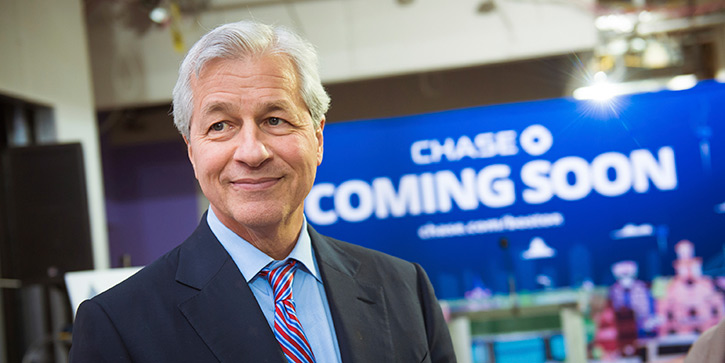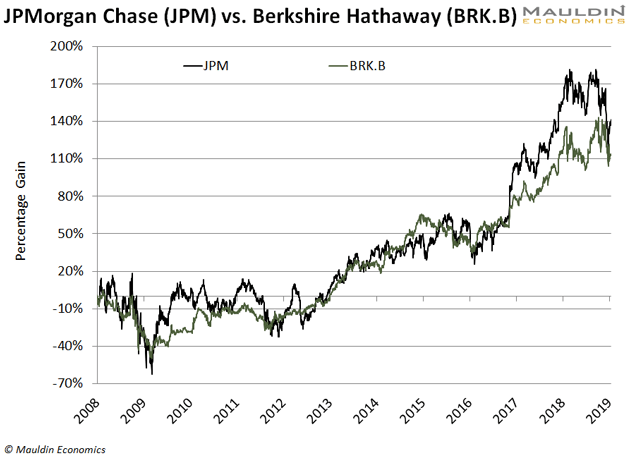
Why You’ll Regret Not Investing in Dividend-Paying Stocks
- Robert Ross
- |
- The Weekly Profit
- |
- January 23, 2019
Yes, he’s one of the best—if not the best—investors in history.
His style of value investing has made him one of the richest men in the world.
But my complaint is not with his investing style.
Rather, it’s that his company—Berkshire Hathaway (BRK.B)—does not pay a dividend.
The Payoff from Dividend Stocks Over the Long Haul…
Investing is all about making the right choices.
Let’s look at two companies as examples: Berkshire Hathaway (BRK.B) and JPMorgan Chase (JPM).
Since the 2008 financial crisis, the stocks of both companies have more than doubled:

Shares of JPMorgan Chase gained 141% during this period compared to 113% for Berkshire Hathaway.
That’s a pretty big difference.
However, when you factor in dividends, JPMorgan Chase crushed Berkshire Hathaway.
Dividends Add Up Over Time…
Since the start of 2008, JPMorgan Chase has regularly paid a dividend.
The company’s average dividend yield during this period was 2.8%.
That’s not a huge dividend, but it has roughly matched the average S&P 500 dividend yield.
A modest dividend might not seem like much, but it really adds up.
On January 2, 2008, JPMorgan Chase stock was $42.17.
Since then, the company has paid $16.46 in dividends.
If you had bought shares on that date, you would have earned a 39% return in just dividends.
That boosts JPMorgan Chase’s total return to 180%.
Berkshire Hathaway shareholders who didn’t get paid any dividends are left with the same 113%.
That’s a huge difference. And it’s only over a 10-year period.
Over the past 20 years, JPMorgan Chase has showered investors with an 85% return.... from dividends alone!
And with interest rates rising, you want to own dividend-paying stocks.
Even more important, you must own the right kind of dividend-paying stocks.
|
It All Comes Back to the Right Choices…
When interest rates are low, it’s cheaper for a company to borrow money.
When rates climb higher, the opposite happens. It costs more for a company to run and grow its business.
That can lower a company’s earnings and drag down its share price.
But this isn’t true for all stocks.
A study by ETF provider Global X Funds found that between 1960 and 2017, stocks that performed best in a rising rate climate were high dividend-paying stocks.
How high? Stocks that paid 6.4% or better handed investors returns that beat the S&P 500.
Picking the Sharpest Tool in the Shed…
Stocks with high dividends beat the S&P 500 in seven of the last 10 periods when interest rates were climbing.
You don’t, however, want to buy just any stock with a big dividend. Many companies are forced to pay fat dividends as a way to lure investors.
Some of these companies actually borrow money and use the debt to pay their dividend. That’s a disaster in the making for investors.
That’s why I developed a tool that helps gauge the safety of a company’s dividend.
I call it the Dividend Sustainability Index (DSI).
How to Select the Right Dividend-Paying Stock…
You must look at three key things when evaluating dividends.
The most important is the payout ratio.
The payout ratio is the percentage of net income a firm pays to its shareholders as dividends.
The lower the payout ratio, the safer the dividend payment.
The second is the debt-to-equity ratio.
The more debt a company has, the harder it gets to run a business. This includes—you guessed it—paying the dividend.
The third is free cash flow. This is the amount of cash left over after a company pays its expenses.
If any of these measures is flashing red, you know the dividend is in trouble.
A low DSI score tells me that the odds are high that a company will be forced to cut its dividend.
And that’s bad news for shareholders.
A Dividend Cut Can Wipe Out Your Profits…
A dividend cut is a death sentence for any stock.
Even companies with timeless brands aren’t immune from dividend cuts.
Take a look at what happened to General Electric (GE) when it surprised investors and slashed its dividend 50% in November 2017:

GE shares were punished on the news, getting chopped over 10%.
One year and a second dividend cut later, shares have been smashed 57%.
The Dividend Sustainability Index (DSI) will keep you out of stocks like GE. Every stock in my premium investing service Yield Shark passes the DSI.
I recently recommended that my readers buy a company that yields 7.4% and scored high on the DSI.
Everyone reading this would recognize the name of this company. I’d bet many of you are using their products to read this article right now.
We’ve owned the company for only a month and the stock is up 12%.
That’s 3% better than the S&P 500 over the same period.
And with that safe 7.4% dividend, this company will be rewarding shareholders for years to come.
To find out the name of this stock, plus seven other stocks that passed the Dividend Sustainability Index, click here.

